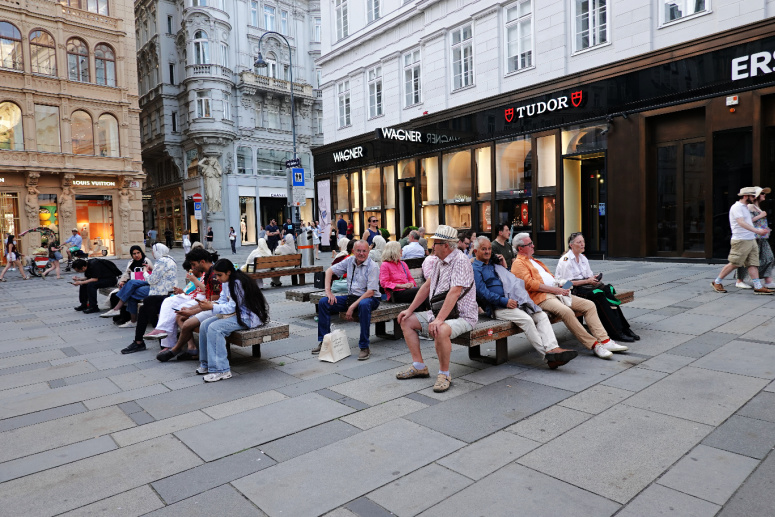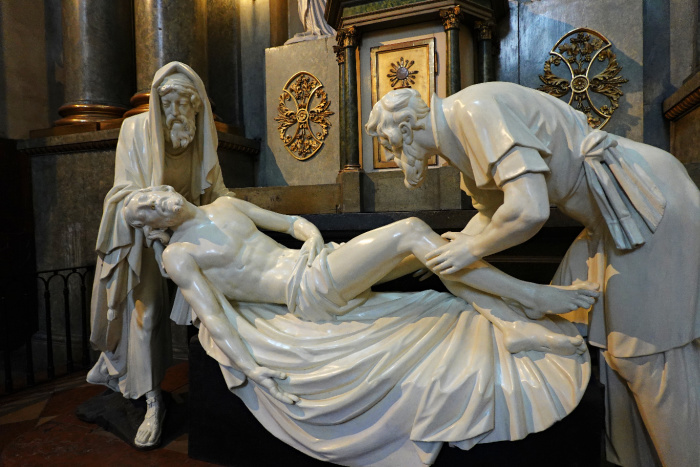After a 7-hour bus ride through the rolling hills of the Czech Republic, we pulled into the Erdberg Bus Terminal in Vienna.We walked across the street and took an elevator down to the subway. It wasn't too difficult to buy our tickets and hop on the orange line. In only four stops we arrived at Landstraẞe, where we exited the underground and returned to the street.
We were in Vienna! As we rolled or carried our luggage, we took note of where we were. The architecture was older, but I knew it wasn't as old as what we'd find in the city center. People everywhere were walking, biking, riding scooters, driving and using the tram.
In just a couple blocks we found our hotel and happily plunged onto the bed and eventually took a one-hour nap. We were exhausted. We were at the end of a two-week vacation and came to Vienna to fly out the following morning. We had one evening in The City of Music, and intended to make the best of it.
After our nap, we were outside once again, but this time without the encumbrance of luggage. (I strategically booked a hotel close to the city center, but one that also had easy access to the airport.) Within a block we came to a large shopping mall, and inside was a two-story grocery store. That was exactly what we needed: a place to grab a bite for now and some snacks for tomorrow.
Interestingly, it was the biggest grocery store we'd been in during our two-week sojourn in Europe. There was a cornucopia of food and other items. I found a mozzarella and tomato baguette sandwich and Jenelle some lasagna.
But the people-watching was the most interesting part of all. There was a different feel to the chaotic crawl of the store. The people⸺although varied and not fitting any single stereotype⸺were taller and had darker hair than I expected to find in Austria. Except for the obviously foreign-born shoppers, most had typical white skin. And, of course, German was the language of the chatter.
 |
| Grocery store in Vienna, Austria. |
We crossed Stadtpark and quickly were immersed in the old historical center of Vienna. Many narrow streets bent slightly, with cobble-stoned paths. Iron railings on the balconies came in elegant styles.
Our first “place of interest” was Mozart's house, an apartment on one of the old narrow streets. A group of Asian tourists stood across the doorway and took pictures. Across the street a small shop sold Venetian masks and costumes, reminiscent of the movie Amadeus. The theme of Vienna throughout the evening was a theme of Vienna being the world capital of classical music.
 |
| Domgasse Street, with the Mozart House on the right. |
Beyond the narrow street, an archway tunnel lead to a big plaza, and the backside of a gigantic church. From this angle we could see the massive outer walls and a myriad of medieval motifs. The steeple was dizzingly tall. This was St. Stephen's Cathedral, an icon of Vienna.
Flanking the house of worship was a line of horse-drawn carriages. As we made our way toward the front, the plaza opened up and suddenly thousands of tourists came into view. It was a madhouse! They walked, took pictures, and many along the outer edge of the plaza sat at outdoor cafes and ate.
 |
| Stephansplatz, a popular square in the center of Vienna. |
 |
| St. Stephen's Cathedral. |
It was sensory overload. We couldn't take it all in. All the buildings surrounding the square appeared elegant and were probably of historical significance. On the corner of the cathedral a carousel took children for rides. On the other end a gigantic souvenir shop dazzled us. We would come there later.
The open door of the cathedral lured us in. The sound of organ music echoed throughout the massive interior, coming somewhat near the front. Tourists respectfully moved around, admiring the tall nave and arches.
As I moved toward the front I passed lit candles, Baroque paintings, and carefully sculpted statues. The music became louder and more distinct until I finally noticed the organ player. He was still at a distance, but I admired his work. I had long hoped to someday come across an organ recital or concert inside a cathedral.
 |
| Candles inside St. Stephen's Cathedral. |
 |
| Inside St. Stephen's Cathedral. |
Back out in the plaza we continued to move, being very conscious not to lose each other in the crowd. Vienna, I could tell, was a large collection of people from everywhere around the world. We quickly noticed the high percentage of Muslims, most dressed in a range of traditional clothing, women in hijabs and scarfs, and some men in long white robes. Many of the women, especially, wore captivating and colorful apparel.
Around each corner was a new architectural masterpiece: elaborate hotels, modern buildings with reflecting windows, St. Peter's Church with its light-green dome, fancy shops and restaurants. In the middle of Graben Street was a large Baroque statue dedicated to the Great Plague of 1679.
 |
| Graben Street and a statue dedicated to the Great Plague of 1679. |
 |
| Many Muslims on the streets of Vienna. |
 |
| Louis Vuitton on Kohlmarkt Street. |
 |
| Taking a rest on Graben Street. |
Kohlmarkt was an intersting street. Here were many high-end stores like Louis Vuittan and Cartier. As we walked closer to Michael Plaza, the soft, deep sound of a stringed instrument floated like sweet aroma. In the background came the clacking of horse's hooves on the cobble-stoned street.
At Michaelerplatz, not only did we find the double bass player, but also a fragment of Roman ruins inside an enclosed viewing area. Below us we saw the bricked walls of a house and the arch of a door. A small stone canal led to the house. It always amazes me how ruins of the past are located so far below the surface.
 |
| Man plays a double bass at Michaelerplatz. |
 |
| Roman ruins in the center of Vienna. |
 |
| People-watching in Vienna. |
Adjacent to the plaza stood St. Michael's Church. It was smaller and less flamboyant than many of its neighbors. We walked inside and found a mostly dark and near empty interior. A lone lady knelt at a pew and prayed. We quietly circled to the sides, admiring the artistry of the paintings and sculptures. One in particular caught my attention: a figure of Christ, after his crucifixion, being laid on a cloth by two of his disciples.
 |
| Inside St. Michael's Church. |
 |
| St. Michael's Church in Michaelerplatz. |
I should mention that it was much hotter and humid than we expected. Except for the occasional cross-breeze, or dampness of a church, we suffered from this pleasant heat. I say “pleasant” because, after all, we were in Vienna.
To alleviate this inconvenience, we found an ice cream shop. We had several Euros and we had to use them up. We sat at the base of a fountain, along with a couple-dozen strangers. We ate our ice cream cones as we people-watched. By the time I got to the bottom the treat was melting and the waffle cone crumbling. It still hit the spot.
By now dusk was settling in and the hue on the cathedral and other buildings was changing. Some of the places, like the carousel, now had on their lights. People wore a variety of clothing, including women now wearing evening dresses.
We returned to the souvenir shop, one of the biggest I'd ever seen. It had two stories and an endless supply of magnets, postcards, t-shirts, hand bags, small figurines of Viennese landmarks, and a plethora of other items.
 |
| St. Peter's Church. |
The evening wore on and we knew that soon we'd need to return to our hotel to catch a morning flight. I had one last request, and that was to eat a wiener schnitzel while in Vienna. "Wien" is the German name for "Vienna."
I had a restaurant in mind on a street down from St. Stephen's Plaza. It was the Figlmüller and claimed to be the original home of the wiener schnitzel. But as we met the server at the doorway, we learned they had no tables available.
We moved to another place around the corner, but there was a line out the door. Then, Jenelle found a place down the street. Immediately we were seated and handed a menu.
Maybe they'd never heard of air conditioning in Austria. It was stuffy. No fans to blow the air, but at least the windows were open. The restaurant seemed to be dominated by shades of the color red, and had a feel from the 1920's.
 |
| Kaffee Alt Wien. |
It didn't take long to decide what I wanted. It came in either pork, veal or chicken, and since I had eaten neither veal nor wiener schnitzel in my lifetime, that's what I chose.
It came with two schnitzels, a side of cranberry sauce, and a small bowl of parsley potatoes. It looked exactly like all the picture's I'd seen.
To make wiener schnitzel one has to pound and flatten the meat, then deep-fry it in batter.⸺It tasted how I thought it would, largely dominated by the taste and texture of the batter. I thought it was a little on the dry side, but was improved when accompanied with the cranberry sauce. I followed each bite with a chunk of buttery parsley potatoes. It was a good compliment.
 |
| Wiener schnitzel. |
Our evening was now over. We lazily walked toward our hotel, taking everything in. It was now dark, but the city still buzzed with life. We passed a group of over a dozen couples waltzing to classical music. We watched in amazement as the couples moved in step, their legs and arms knowing exactly what to do and where to go. We both agreed that this was a lost art in the States.
We were both beat and feeling bloated from force-feeding ourselves all this “cultural” food. We were ready to get back to the hotel and sleep. But our evening in Vienna would never escape our minds. What a beautiful, pleasant and vibrant city! ♠
 |
| Evening of waltzing in Vienna. |






















No comments:
Post a Comment